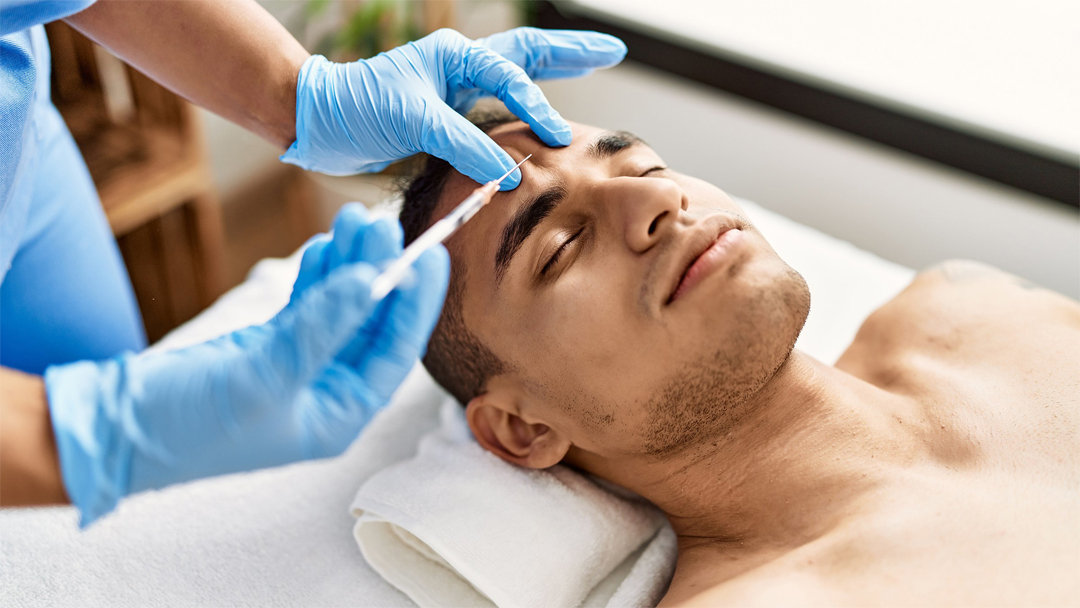
What is Botox?
Botox is a protein that is made from the Botulinum toxin, produced by the bacterium Clostridium botulinum. This bacteria is easily found in many natural settings such as forests, soils, lakes, and mammals and fish intestinal tracks. Botox is an FDA-approved treatment. The administration of botox in the right quantities helps smooth fine lines, prevent migraines, and more. This toxin can also cause a serious health condition called botulism if overdosed.
The nerves in our body release a chemical messenger called acetylcholine that helps any muscle contract. Botox injections prevent the release of acetylcholine. The neurotoxins present in botox affect the nerves and causes muscle weakening. This is achieved because botox blocks the nerve signals to the muscles. Thus, the muscle can no longer contract or tense up, which helps achieve the desired results.
The effects of the botox treatment last for around five to six months, after which the individual can consider retreatment if needed. The common areas on the face that this botox injection is administered include the forehead, nose, eyebrows, jawline, neck, eyes, lips, and chin.
For other medical conditions like overactive bladder, hyperhidrosis, Osteoarthritis, etc., these injections can also be injected into other body parts.
What is the Total Botox Procedure Like?
Botox is a safe treatment if administered by a licensed healthcare provider. Listed below are some of the botox treatments before, during, and after processes.
1. Before the Botox Treatment
Before the treatment, the doctor usually conducts a full medical examination of the patient. They also look into their medical history and understand what overall results the patient is expecting from the treatment.
Based on the answers that are deduced, the plans for the treatment are designed. Those who take medications like blood thinners and nonsteroidal anti-inflammatory drugs (NSAIDs) are advised not to go for the botox treatment as it increases the risk of injuries on the injection site.
It is also advised to avoid the intake of alcohol at least 24 hours before the treatment. This is because it makes the patient prone to redness and bruising.
2. During the Botox treatment
The healthcare provider uses a small disinfected needle to inject small amounts of botox into the treatment area during the botox treatment. Depending on the severity of the condition, patients can be injected with several injections at different spots.
For certain conditions, such as overactive bladder, the patient is given either local or regional anesthesia to ease the pain and discomfort. The healthcare provider might apply a numbing agent to the skin for other conditions before injecting the doses.
3. After the Botox Treatment
Botox is an outpatient procedure, meaning the patient is discharged on the same day the treatment is conducted. Usually, the patient can get back to normal activity almost immediately after the treatment.
However, it still becomes important to follow some precautionary measures to avoid the risk of any side effects. Firstly, it is important to remember that the injected area should not be rubbed or pressurized for at least 12 hours after the treatment.
The patients are also advised to stay upright for three to four hours after getting botox. One should also avoid performing any strenuous physical activity. Following all these simple guidelines will help in reducing or preventing redness, swelling, or bruising.
Is the Botox Treatment Painful?
There are exceptions in the case of medical conditions like overactive bladder, where the patient might find the treatment painful without anesthesia.
Most people associate the fear of needles or injections with the pain that they think botox treatment will deliver. But this is only a false claim, as a lot of people taking botox treatments have experienced zero pain.
Although, these patients did feel a slight stinging at the injection site during the botox treatment.
However, even this discomfort is put to rest with the help of the topical cream that is applied before the treatment. To reduce any signs of redness or bruising, the physician constantly applies an ice pack before, during, and after the botox treatment.
On the contrary, botox is actually also used as an effective solution for pain management. These injections block nerve signals that control muscle activity and thus help relieve pain aroused due to some medical conditions.
Some of these conditions include back, neck, jaw, nerve, sciatica, neuropathy, pelvic pain, and more.
Is Botox Painful After the Treatment?
Redness, bruising, and swelling are common after getting the botox treatment. But these gradually subside if the instructions given by the doctor are rightfully followed. Pain is not experienced by most even after the treatment.
However, in unexpected situations, the patient might become a victim of some adverse side effects of botox. These include pain, flu-like symptoms, neck pain, headache, temporary drooping eyelids (ptosis), eye irritation or redness, and indigestion.
If any of these side effects are experienced even after a couple of days, then it becomes important to consult the doctor as soon as possible.
Conclusion
Botox is a very trusted procedure for a lot of cosmetic and medical conditions. However, its popularity mostly lies in its ability to reduce or get rid of age-related signs. Despite its many benefits, one always has to get expert advice to know whether or not they are an ideal candidate for the botox treatment.
Comments
comments